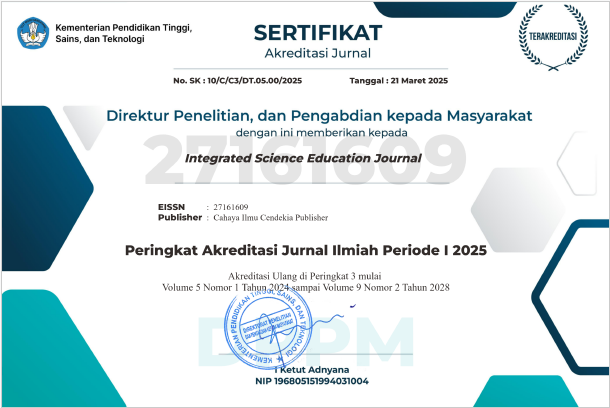The Rasch Model: Implementation of Physics Learning Evaluation Instrument Based on Higher Order Thinking Skills
Abstract
Purpose of the study: This research was conducted to analyze the test instruments used to measure students' HOTS abilities on static fluid material at Senior high school 2 Jambi City.
Methodology: The evaluation instrument provided was in the form of 20 items of two-tier multiple choice questions related to static fluid material. The Rasch model is used to get fit items. This analysis was carried out with the help of Ministeps software. Respondents in this study were 36 students of class XI MIPA 1 Senior high school 2 Jambi City.
Main Findings: From the output of the Ministeps program, the results obtained were 20 questions according to the Rasch model with an average Outfit MNSQ score for person and item respectively 0.94 and 0.94. While the Outfit ZSTD values for persons and items are 0 and -0.1 respectively, while the reliability of the instrument expressed in Cronbach's alpha is 0.79.
Novelty/Originality of this study: The evaluation instrument used for physics subjects on static fluid material is fit with the Rasch model. so that the instrument meets the criteria for use.
References
I. Magdalena, H. N. Fauzi, and R. Putri, “Pentingnya Evaluasi Dalam Pembelajaran Dan Akibat Memanipulasinya,” J. Pendidik. dan Sains, vol. 2, no. 2, pp. 244–257, 2020.
A. N. Phafiandita, A. Permadani, A. S. Pradani, and M. I. Wahyudi, “Urgensi Evaluasi Pembelajaran di Kelas,” JIRA J. Inov. dan Ris. Akad., vol. 3, no. 2, pp. 111–121, 2022, doi: 10.47387/jira.v3i2.262.
S. Aqliyah, “Pembuatan Media Evaluasi Pembelajaran dengan Quizizz di SMK Annur Pasaleman pada Mata Pelajaran Simulasi dan Komunikasi Digital,” vol. 1, no. 2, pp. 1–29, 2022.
I. P. Suardipa and K. H. Primayana, “Peran Desain Evaluasi Pembelajaran Untuk Meningkatkan Kualitas Pembelajaran,” Widyacarya, vol. 4, no. 2, pp. 88–100, 2020.
D. Desilva, I. Sakti, and R. Medriati, “Pengembangan Instrumen Penilaian Hasil Belajar Fisika Berorientasi HOTS (Higher Order Thinking Skills) pada Materi Elastisitas dan Hukum Hooke,” J. Kumparan Fis., vol. 3, no. 1, pp. 41–50, Apr. 2020, doi: 10.33369/jkf.3.1.41-50.
N. W. Putri and R. Dwijayanti, “Pengembangan Alat Evaluasi Bantuan Aplikasi ‘Quizizz’Pada Mata Pelajaran Marketing Kelas X Jurusan Bdp Di Smk Negeri 10 Surabaya,” J. Pendidik. Tata Niaga, vol. 8, no. 3, pp. 985–991, 2020.
L. . Anderson and D. . Krathwohl, A Taxonomy for Learning, Teaching, and Assesing. New York: Longman, 2001.
E. Cahyono, S. Lathif, Y. Pantiwati, and A. S. Budi, Pengembangan Perangkat Pembelajaran Berorientasi HOTS Tingkat Sekolah Dasar. 2020.
S. Arikunto, Dasar-dasar Evaluasi Pendidikan. Jakarta: Bumi Aksara, 2013.
D. F. Treagust, “Diagnostic assessment in science as a means to improving teaching, learning and retention,” 2006.
T. M. Haladyna and S. M. Downing, “Applied Measurement in Education A Taxonomy of Multiple- Choice Item-Writing Rules,” Appl. Meas. Educ., vol. 2, no. 1, pp. 37–50, 1989.
M. Nofiana, S. Sajidan, and P. Puguh, “Pengembangan Instrumen Evaluasi Two-Tier Multiple Choice Question untuk Mengukur Keterampilan Berpikir Tingkat Tinggi pada Materi Kingdom Plantae,” J. Inkuiri, vol. 3, no. 2, pp. 60–74, 2014.
Y. Pantiwati and N. Mahmudati, “Increased ability to arrange two tier multiple choice questions,” J. Community Serv. Empower., vol. 2, no. 1, pp. 22–27, 2021, doi: 10.22219/jcse.v2i1.15855.
L. W. Olsen, Essays on Georg Rasch and his contributions to statistics. Unpublished Ph.D thesis at Institute of Economics University of Copenhagen., 2003.
J. M. Linacre, “A User’s guide to WINSTEPS Ministeps; Rasch-model Computer Program. Program Manual 3.73.” 2011.
B. Sumintono and W. Widhiarso, Penilaian Pendidikan dan Ujian. 2015.
J. M. Linacre, “Investigating rating scale category utility,” J. Outcome Meas., vol. 3, no. 2, pp. 103–122, 1999.
G. Englehard, Invariant Measurement, using rasch models in the social, behavioral and health sciences. New York: Routledge, 2013.
Y. Irhasyuarna., F. Fahmi., and I. Setiadi, “Mengembangkan keterampilan berpikir tingkat tinggi melalui pembelajaran IPA,” Prosiding Magister Pendidikan Ilmu Pengetahuan Alam, vol. 1, no. 1, 2021.
B. Mok, M. and Wright, Overview of Rasch Model Families.In Introduction to Rasch Measurement: Theory, Models and Applications. Minnesota: Jam Press, 2004.
B. Sumintono and W. Widhiarso, “Aplikasi Model Rasch Untuk Penelitian Ilmu-Ilmu Sosial,” 2014.
M. Rozeha, AR, Azami, Z. & Mohd Saidfudin, “Application of Rasch Measurement in Evaluation of Learning Outcomes: A Case Study in Electrical Engineering. Regional Conference on Engineering Mathematics, Mechanics, Manufacturing & Architecture 2007 (EM3ARC).” 2007.
Thissen, D., Nelson, L., Rosa, K., Item Response Theory for Items Scored in More than Two Categories in D. Thissen & H. Wainer, Test Scoring. New Jersey: Lawrence Erlbaum Associates Publishers, 2001.
D. Ardiyanti, “Application of the Rasch Model on the Development of the Self-Efficacy Scale in Student Career Decision Making,” J. Psychol., vol. 43, no. 3, pp. 248–263, 2016.
R. Aziz, “Application of the Rasch model in testing mental health measures at work. Psychoislamika,” J. Islam. Psychol. Psychol., vol. 12, no. 2, pp. 29–39, 2015.
Y. Wisman, E. Effrata, and T. Tutesa, “Penerapan Konsep Instrumen Evaluasi Hasil Belajar,” J. Ilm. Kanderang Tingang, vol. 12, no. 1, pp. 1–9, 2021, doi: 10.37304/jikt.v12i1.105.
E. Suseno, “Measuring Test Validity. educative speaker.” 2021.
Kustriyono, “Penyusunan Perangkat Soal Ujian Akhir Mata Pelajaran SainsBiologi Dalam Rangka Pengembangan Bank Soal,” J. Penelit. dan Eval. Pendidik., vol. 2, no. VI, pp. 175–198, 2004.
A. Gunasti, A. Sanosra, N. A. Mufarida, and E. B. Satoto, “Pemanfaatan Rasch Model untuk Mengukur Kemampuan,” vol. 7, no. 2, pp. 1544–1557, 2023.
B. Sumintono, “Penilaian Keterampilan Berpikir Tingkat Tinggi: Aplikasi Pemodelan Rasch pada Asesmen Pendidikan,” in Prosiding Magister Pendidikan Ilmu Pengetahuan Alam, 2021.
E. Rosita, W. Hidayat, and W. Yuliani, “Uji Validitas Dan Reliabilitas Kuesioner Perilaku Prososial,” FOKUS (Kajian Bimbing. Konseling dalam Pendidikan), vol. 4, no. 4, p. 279, 2021, doi: 10.22460/fokus.v4i4.7413.
Azizah and S. Wahyuningsih, “Penggunaan Model Rasch Untuk Analisis Instrumen the Use of Rasch Model for Analyzing Test,” J U P I T E K J. Pendidik. Mat., vol. 3, no. 1, pp. 45–50, 2020.
Copyright (c) 2023 Rika Irmayanti, Muhammad Rusdi, Yusnaidar Yusnaidar

This work is licensed under a Creative Commons Attribution-NonCommercial 4.0 International License.
Authors who publish with this journal agree to the following terms:
- Authors retain copyright and acknowledge that the Integrated Science Education Journal is the first publisher licensed under a Creative Commons Attribution 4.0 International License.
- Authors are able to enter into separate, additional contractual arrangements for the non-exclusive distribution of the journal's published version of the work (e.g., post it to an institutional repository or publish it in a book), with an acknowledgment of its initial publication in this journal.
- Authors are permitted and encouraged to post their work online (e.g., in institutional repositories or on their website) prior to and during the submission process, as it can lead to productive exchanges and earlier and greater citation of published work.







.png)
.png)






